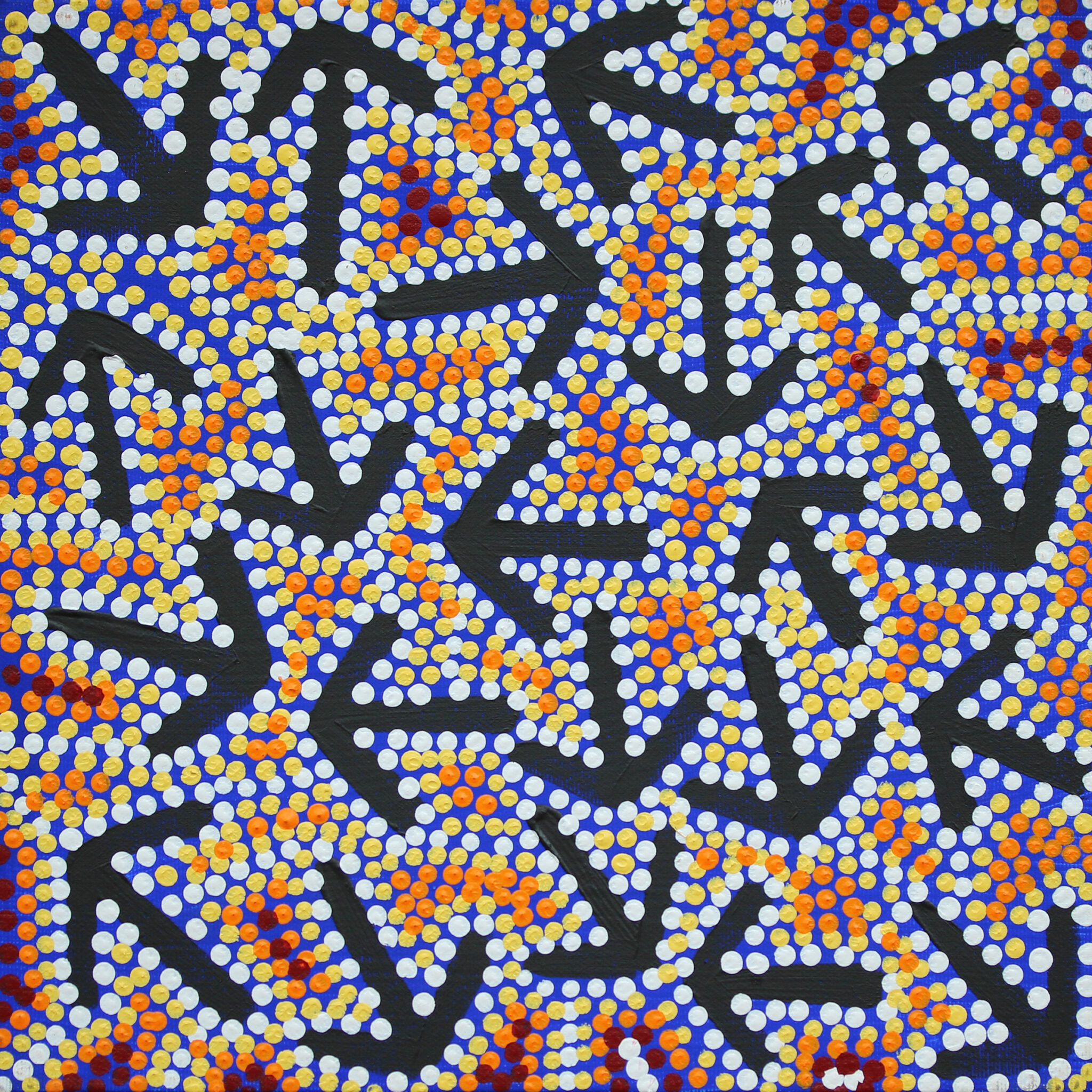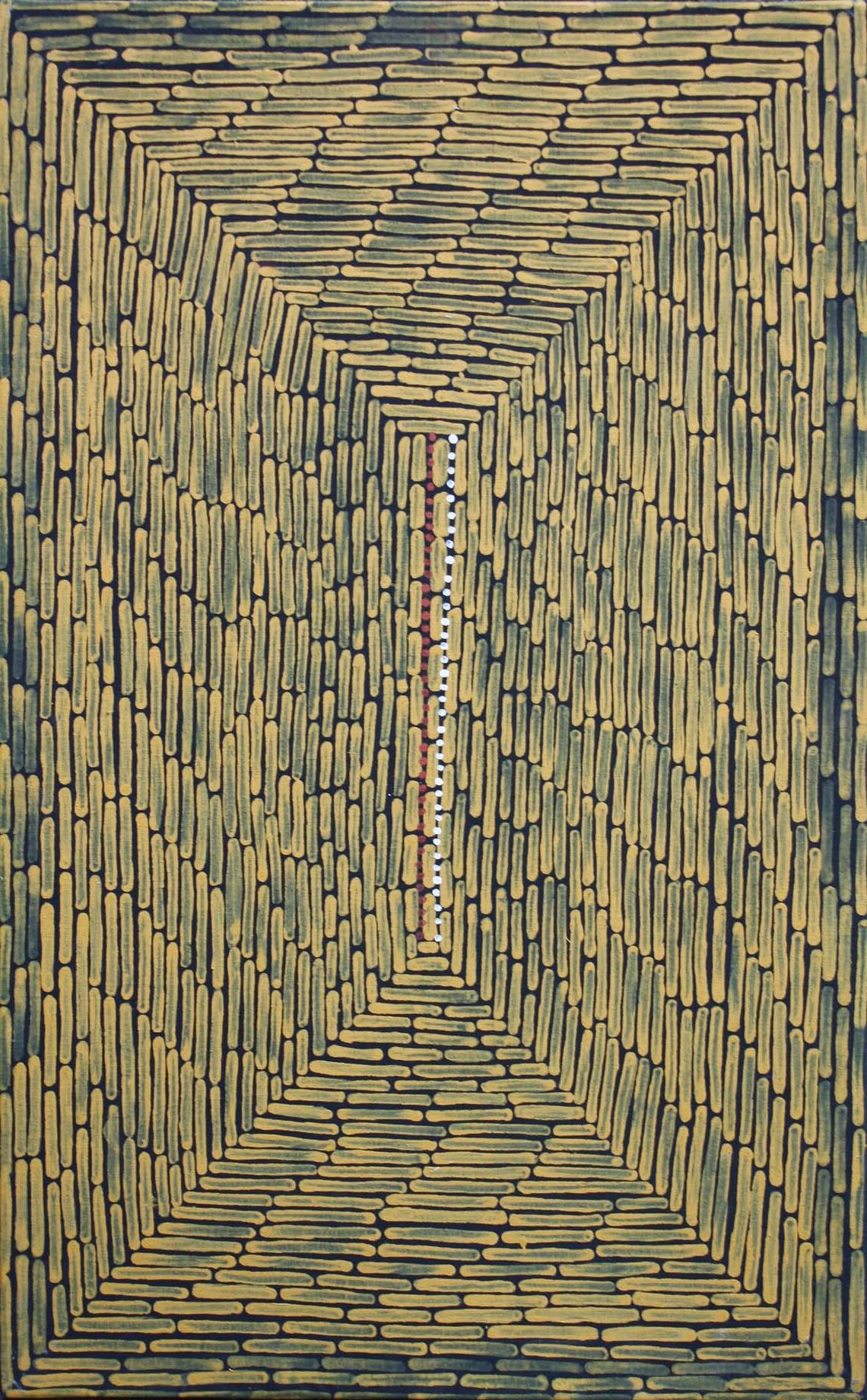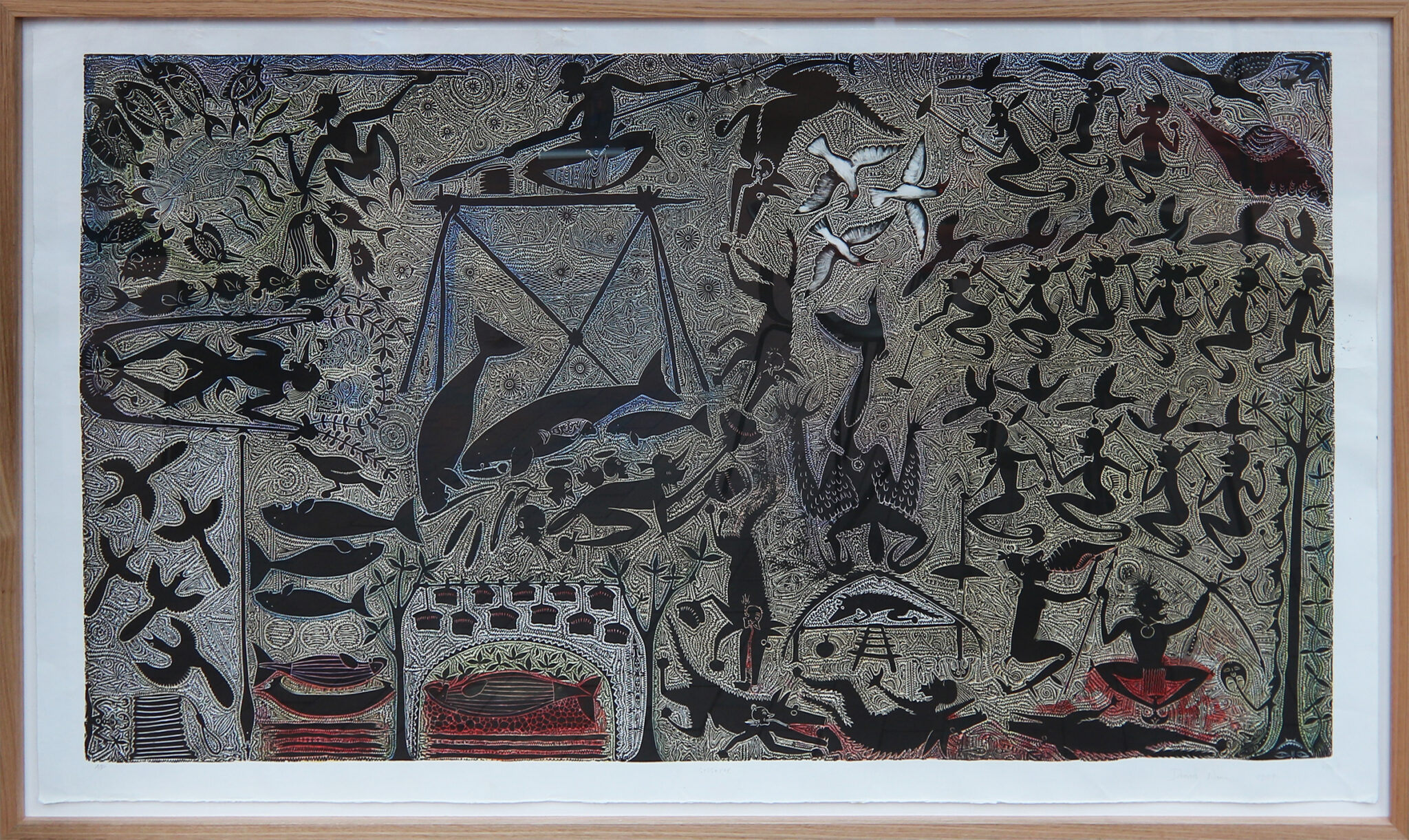Serial:
Size:
$14,390 (tax inc.)
SOLD
The story:
Story: The Wakaid Clan of Badu Island tell the legend of the Willy Wagtail bird. Sesserae, a young man of Tulu went fishing every morning at low tide. He would often fish on other peoples traditional fishing grounds. Boundary rocks were set by different family clans and punishment was often given to him in the form of breaking all his spears. One day he began fishing in a particular lagoon and noticed the seagrass had been eaten in large quantities. He thought a very large fish must have eaten it or even perhaps a whale. In the evening he plucked some takarr matua leaves from a bush, and in the ritual way, rubbed them on the skulls of his ama-du (mother) and his baba-du (father). He lay down beside them and prayed to them for a dream, that he might discover what animal was visiting the lagoon. As he drifted to sleep, he began to hear the delicate scratching noise, like fingernails clicking, inside the skulls. In the dream he asked his parents, ‘what is eating the seagrass in the lagoon?.’ In the dream, his request was answered, ‘Tomorrow at dawn, when you hear the surrka (bush turkey), go up to the small mountain where there is a tableland. You will see a mutluk bird flying around a tree. This is where you will find a wap (harpoon) made from baidam tul wood, an amu (rope) made from cane fibres and six strong poles’. In the dream he was shown how to lash together a nath (fishing platform) from the poles and to erect it where the seagrass was being eaten. ‘In the afternoon, when the tide comes in, don’t make a noise until you see the fish and then spear it.’ Sessere awoke at dawn by the surrka bird as foretold in the dream. He travelled to where his parents had told him and got the wap, amu and poles and headed for the lagoon, careful not to be seen by anyone else. He built the nath on the lagoon and waited patiently until high tide when he saw a large fish move into the lagoon. Spearing it, the big fish turned out to a dugong, which no one had ever seen before. Delighted by his marvellous catch, he secretly skinned, butchered and cooked it in different traditional ways, roasting the great chunks of meat in a traditional Kupmari ground oven, baking it over hot embers and drying the rest on poles. Careful not to attract attention, the next week he killed many more dugong and cooked them up. But the neighbouring tribes people became curious about Sessere’s nath and the wonderful sweet smell of the large quantity of cooking meat and this was soon brought to the attention of the elders and sorcerers of village Zaum. They sat together and drew up plans to discover what Sessere was up to. The sorcerers decided to hide a man inside a constructed dog and to report back. They made the dog out of ewig (bamboo cane) for the bones, coconut fibres for the hair and pigs ribs for the teeth. To test whether their creation was convincing, they sent the dog onto the beach to test it before a flock of seagulls. Without the dog even giving chase, the seagulls squabbled loudly and flew away in fright. The sorcerers were convinced their creation would fool Sesserae and quickly made two more. The three dogs were sent to Sessere. They followed him from behind, straggling, and looking hungry. Sesserae fed them some small pieces of smoked dugong meat. Sessere had only enemies and in need of companionship adopted the dogs as his friends. Later, however, the dogs sneaked away to the Zaum sorcerers and told them of his plentiful supply of dugong meat and described the necessary means to catch them. Sessere was pleased with his new friends and made contact with his ancestral spirits to tell them. His parents warned Sesserae that the dogs were not real dogs and that he was in danger. They told him to kill one with an arrow and that it would reveal that there was really a person inside. The dogs returned again and Sesserae fed them but this time he killed one and found that his parents were telling the truth. The other dogs returned to Zaum and reported what had happened. Warriors were summoned to attack Sessere. The Zaum warrior Manalbau blew the bu (trumpet conch), gathering his warriors together to attack Sesserae. Once more, Sesserae, trusting his parents’ advice, consulted them as what to do in this difficult situation. He was told to collect white and black clay and to apply it in stripes on his chest. By doing this it would turn him into a willy wagtail. He was told to jump on the warriors’ heads and fly away just before being struck by the warrior’s club. As predicted, the warriors charged Sesserae, but not before he could paint himself with the clay and chanting and dancing was able to avoid capture by turning into a fast and agile bird. Sessere landed on each warrior’s head and taking the advice of his parents, leaped into the air just before an exacting blow could kill him, until the last of the Zaum warriors decided to get help from Upai. Warriors arrived from Upai, but now Sesserae began to feel very tired and he consulted his parents again. This time, they told him to do the same routine and fly from one warrior’s head to the next until each was killed – but if he should tire, to seek shelter inside the conch shell. Sesserae was attacked by the Upai warriors and just as his parents predicted, he became tired from the fight and retreated to the conch shell. Instead of the shell protecting him, a warrior smashed his hiding place and Sesserae sought refuge in the bush, never to take human form again. Sesserae continues to elude the people of Badu and remains a flighty, cheeky bird who prefers his selfish ways, not sharing with the other islanders.
Related artwork:
Related products
-
29 Hunter St, Hobart 7000,
Tasmania, Australia - +61 3 6236 9200
- euan@artmob.com.au
Cash – locally only – up to $10,000 only. Layby facilities available. Card details can be advised securely using WhatsApp.
© Art Mob Pty Ltd, Aboriginal Fine Art Dealer, all rights reserved.



